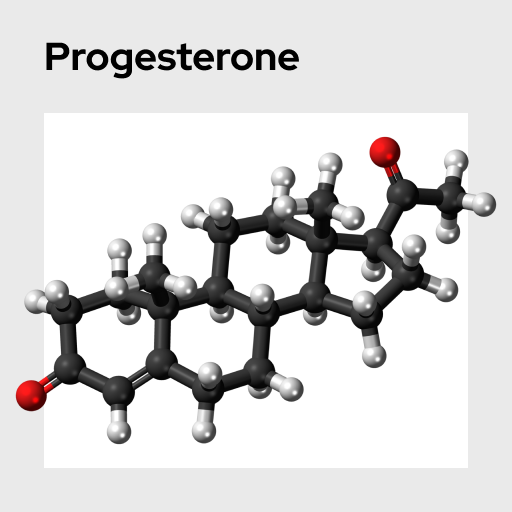Progesterone
Progesterone is a female sex hormone that is released in large quantitates after ovulation, in the luteal phase of the menstrual cycle. It plays a critical role in pregnancy and is known to have anxiolytic effects. Progesterone also modulates immune function both within and outside the context of pregnancy.
Name: Progesterone
Category: Women’s sex hormones
Type of Test: Blood + Saliva
Progesterone (P4, Pg, Pregnenedione, or Pregn-4-ene-3,20-dione) is an essential steroid hormone and the primary progestogen. Progesterone primarily binds to the progesterone receptor (PR), but also has binding affinity for other steroid receptors, such as the glucocorticoid receptor. Progesterone plays a critical role in regulating the menstrual cycle, as well as conception and the maintenance of pregnancy. Specifically, an increase in progesterone during the luteal phase of the menstrual cycle stimulates the endometrium's thickening in preparation for implantation. During pregnancy, progesterone is involved in promoting fetal immunotolerance (suppressing the immune system to allow the body to accept pregnancy), inhibition of myometrial contractions, cervical and uterine maintenance, and blood pressure regulation. Furthermore, a decrease in the binding of progesterone to PRs is responsible for the onset of labor. Although it is often referred to as a female sex hormone, progesterone is present at similar levels in both men and women. In men, it plays a role in spermatogenesis, sperm motility, and testosterone synthesis. Progesterone also influences behavior, cognition, immune system function, kidney function, adipose tissue distribution, and tumor growth in both sexes.
Like all steroid hormones, progesterone is synthesized from cholesterol. In women, this synthesis occurs primarily in the cells of the ovaries' corpus luteum during the menstrual cycle and early pregnancy. However, progesterone can also be produced in the adrenal glands, testes, the placenta during pregnancy, and the brain. Progesterone is also involved in regulating the synthesis of many other steroid hormones, including aldosterone, cortisol, testosterone, and estradiol. Additionally, progesterone is metabolized into GABA-ergic neurosteroids, such as allopregnanolone and pregnanolone. Progesterone and these metabolites have been shown to influence emotional processing, memory, and the stress response. Moreover, they have also been implicated as causal factors for mood disturbances in women with premenstrual syndrome (PMS) and premenstrual dysphoric disorder (PDD)
Progesterone levels can be determined via serum / plasma and saliva samples. However, assaying serum / plasma is the preferred method for accurate measurement of the amount of this hormone in circulation. The extent to which progesterone levels in serum / plasma and saliva correlate is uncertain and likely varies based on a number of factors, such as sex, menstrual cycle phase, and pregnancy status.
Brinton, R. D., Thompson, R. F., Foy, M. R., Baudry, M., Wang, J., Finch, C. E., … Nilsen, J. (2008). Progesterone receptors: Form and function in brain. Frontiers in Neuroendocrinology, 29, 313–339. https://doi.org/10.1016/j.yfrne.2008.02.001
Oettel, M., & Mukhopadhyay, A. (2004). Progesterone: The forgotten hormone in men? The Aging Male, 7, 236-257. https://doi.org/10.1080/13685530400004199
Sundström-Poromaa, I., Comasco, E., Sumner, R., & Luders, E. (2020). Progesterone – Friend or foe? Frontiers in Neuroendocrinology, 59, 100856. https://doi.org/10.1016/j.yfrne.2020.100856
Wassell, J., Rogers, S., Felmingam, K. L., Pearson, J., & Bryant, R. A. (2015). Progesterone and mental imagery interactively predict emotional memories. Psychoneuroendocrinology, 51, 1–10. https://doi.org/10.1016/j.psyneuen.2014.09.005






